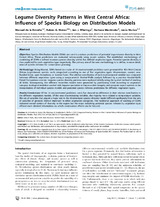Legume Diversity Patterns in West Central Africa: Influence of Species Biology on Distribution Models

Ver/
Autor
Estrella, Manuel de la
Mateo, Rubén G.
Wieringa, Jan J.
Mackinder, Barbara
Muñoz, Jesús
Editor
Public Library Of Science (PLOS)Fecha
2012Materia
Species Distribution ModelsLeguminosae
Central Africa
METS:
Mostrar el registro METSPREMIS:
Mostrar el registro PREMISMetadatos
Mostrar el registro completo del ítemResumen
Objectives: Species Distribution Models (SDMs) are used to produce predictions of potential Leguminosae diversity in West
Central Africa. Those predictions are evaluated subsequently using expert opinion. The established methodology of
combining all SDMs is refined to assess species diversity within five defined vegetation types. Potential species diversity is
thus predicted for each vegetation type respectively. The primary aim of the new methodology is to define, in more detail,
areas of species richness for conservation planning.
Methodology: Using Maxent, SDMs based on a suite of 14 environmental predictors were generated for 185 West Central
African Leguminosae species, each categorised according to one of five vegetation types: Afromontane, coastal, nonflooded
forest, open formations, or riverine forest. The relative contribution of each environmental variable was compared
between different vegetation types using a nonparametric Kruskal-Wallis analysis followed by a post-hoc Kruskal-Wallis
Paired Comparison contrast. Legume species diversity patterns were explored initially using the typical method of stacking
all SDMs. Subsequently, five different ensemble models were generated by partitioning SDMs according to vegetation
category. Ecological modelers worked with legume specialists to improve data integrity and integrate expert opinion in the
interpretation of individual species models and potential species richness predictions for different vegetation types.
Results/Conclusions: Of the 14 environmental predictors used, five showed no difference in their relative contribution to
the different vegetation models. Of the nine discriminating variables, the majority were related to temperature variation.
The set of variables that played a major role in the Afromontane species diversity model differed significantly from the sets
of variables of greatest relative important in other vegetation categories. The traditional approach of stacking all SDMs
indicated overall centers of diversity in the region but the maps indicating potential species richness by vegetation type
offered more detailed information on which conservation efforts can be focused.
